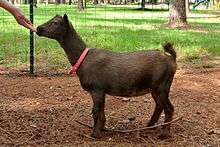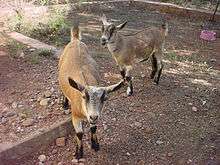Nigerian Dwarf goat
The Nigerian Dwarf is an American breed of dwarf goat. Like the American Pygmy Goat, it derives from the West African Dwarf group of breeds of West Africa.[4]:416
 A 6-month-old doe | |
| Conservation status | |
|---|---|
| Country of origin | United States |
| Standard | |
| Use |
|
| Traits | |
| Height |
|
| Wool color | any color |
| Horn status | horned or hornless |
| |
History
Between about 1930 and 1960 a variety of small goats of the West African Dwarf group of breeds were imported from Africa to the United States to be exhibited in zoos.[2] The Nigerian Dwarf, like the American Pygmy Goat, derives from these, but does not resemble the stocky West African Dwarf in conformation – it has been bred to have the appearance of a miniature dairy goat.[4]:399[5]:35 It was at first reared as a show breed and companion animal; selection was for appearance and for docility.[2] It was later found to be suitable for small-scale dairy production, and some breeding was directed towards dairy qualities.[2] A herd-book was established in 1980.[3]
Numbers grew rapidly; by 2002 there were almost 7000 head registered.[2] The breed was recognized by the American Dairy Goat Association in 2005.[5]:33 The Nigerian Dwarf was formerly listed on the heritage breeds watchlist of the Livestock Conservancy as "recovering",[2] but was removed from the list in 2013.[6]
In the 1990s the Nigora breed was created by cross-breeding the Nigerian Dwarf with Angora and other mohair breeds.[4]:399
Characteristics
The Nigerian Dwarf is small but well-proportioned; its conformation resembles that of larger dairy goats.[4]:399 It may be horned or naturally hornless.[2] The coat is fine and fairly short, and may be of any color, or multicolored;[2] common colors are gold, chocolate and black, frequently with white markings. The facial profile may be concave or straight; the ears are upright.[4]:399 The average weight is approximately 35 kg (75 lb), while maximum height is about 60 cm (24 in) for males and slightly less for females;[4]:399 stock bred for dairy performance may be rather larger than show or companion animals.[2]
It is a precocious breed – young stock may be bred from an early age: males from about three months, females from seven or eight months.[7] The gestation period is in the range 145–153 days;[7] the twinning rate is high, and triplet and quadruplet births are not uncommon.[4]:399[2] Life expectancy is from 8–12 years.[7]
Use

The Nigerian Dwarf was originally bred for show and as a companion animal. It was later also bred for dairy use.[2] Average milk yield of dairy stock is 340 kg (750 lb) per year;[8]:284 the highest recorded annual yield is 782 kg (1720 lb) in a lactation of 305 days.[8]:277 Lactation usually lasts for about ten months.[2] The milk is high in butterfat and protein, averaging 6.5% and 3.9% respectively,[8]:284 and is suitable for making cheese and butter.[2]
References
| Wikimedia Commons has media related to Nigerian Dwarf Goat. |
- Barbara Rischkowsky, D. Pilling (eds.) (2007). List of breeds documented in the Global Databank for Animal Genetic Resources, annex to The State of the World's Animal Genetic Resources for Food and Agriculture. Rome: Food and Agriculture Organization of the United Nations. ISBN 9789251057629. Accessed January 2017.
- Nigerian Dwarf Goat. American Livestock Breeds Conservancy (now The Livestock Conservancy). Archived 7 March 2010.
- Breed data sheet: Nigerian Dwarf / United States of America (Goat). Domestic Animal Diversity Information System of the Food and Agriculture Organization of the United Nations. Accessed December 2019.
- Valerie Porter, Lawrence Alderson, Stephen J.G. Hall, D. Phillip Sponenberg (2016). Mason's World Encyclopedia of Livestock Breeds and Breeding (sixth edition). Wallingford: CABI. ISBN 9781780647944.
- Jerry Belanger, Sara Thomson Bredesen (2010). Storey's Guide to Raising Dairy Goats, 4th Edition: Breeds, Care, Dairying, Marketing. North Adams, Massachusetts: Storey Publishing. ISBN 9781603425803.
- 2013 Changes to the Conservation Priority List. The Livestock Conservancy. Archived 30 October 2013.
- Dwarf Nigerian Goat. Birmingham, Alabama: Birmingham Zoo. Accessed December 2019.
- Y.W. Park and G.F.W. Haenlein (2010). Milk Production. In: Sandra Golpashini Solaiman (editor) (2010). Goat Science and Production. Ames, Iowa: Wiley-Blackwell. ISBN 9780813820620, pages 275–292.
Further reading
- David, Taylor. Nigerian Dwarf Goats Care: Dairy Goat Information Guide to Raising Nigerian Dwarf Dairy Goats as Pets.
- Niemann, Deborah. Raising Goats Naturally: A Complete Guide to Milk, Meat, and More.
- Damerow, Gail. Your Goats: A Kid's Guide to Raising & Showing.